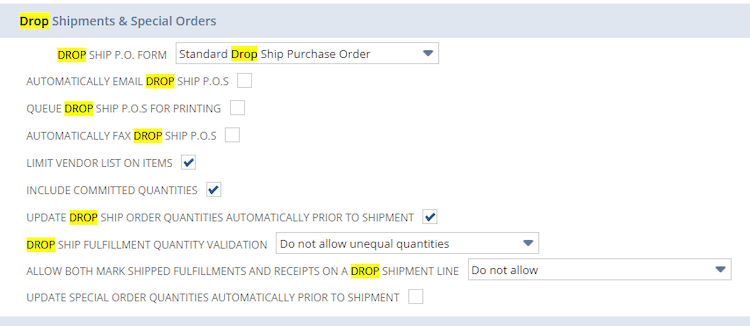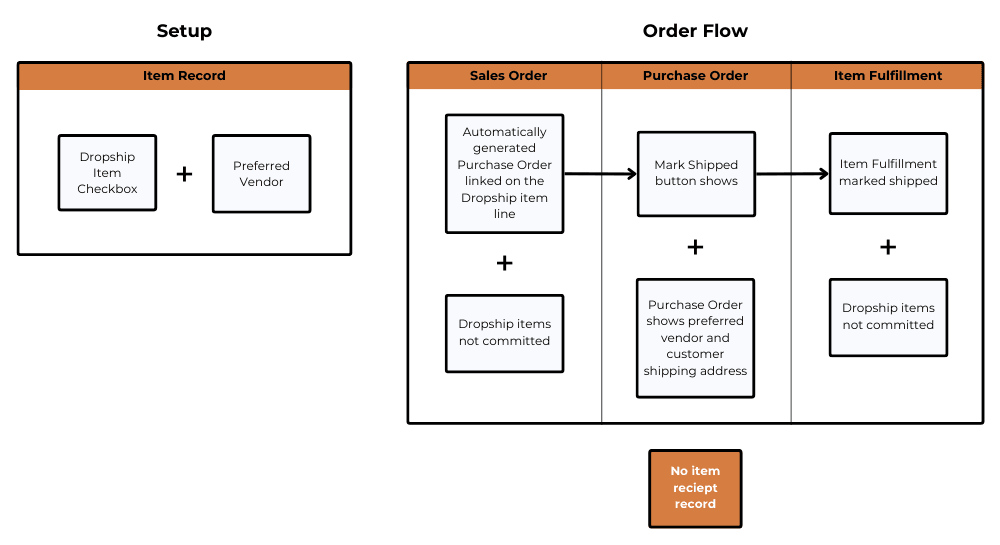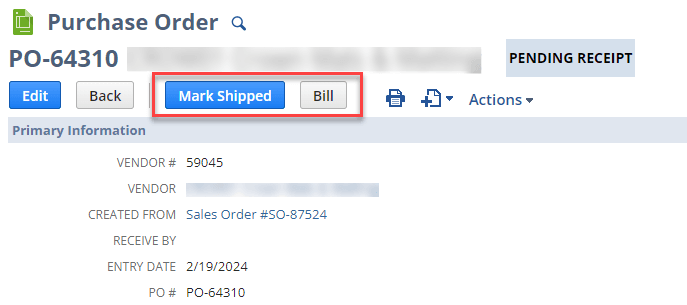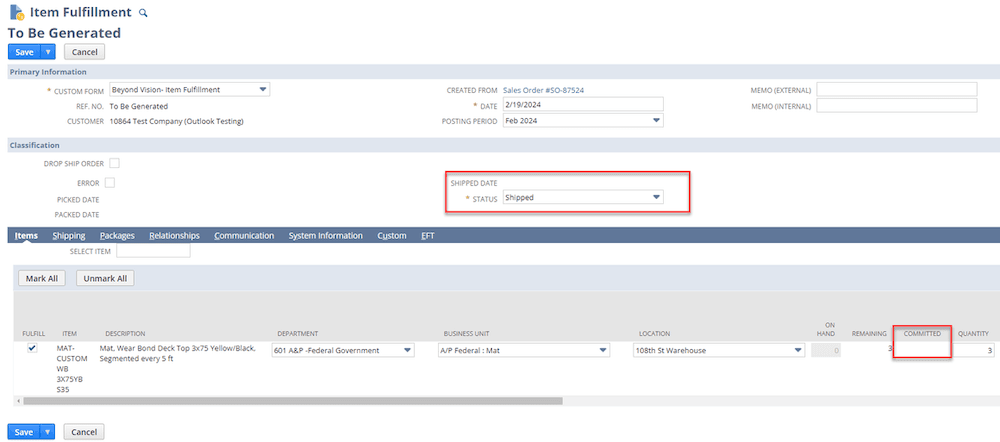A client of ours was having some issues with vendor returns for dropship items. The company wanted the returned quantity to come out of their inventory because they had been receiving the drop shipped items into their inventory once it was returned from the customer. If you've found yourself in a situation with dropship items like the one our client was facing or want to learn more about working with drop shipments in NetSuite, this is the article for you!
NetSuite's drop shipments are not natively designed to receive drop ship items into inventory. This article outlines the native flow of drop shipments, some options for handling, and how returns are designed to work.
Note: This article applies most directly to NetSuite environments with both the Advanced Shipping + Receiving preferences enabled, however, there are also explanations included for environments with one or the other, or neither preference enabled.
What are Drop Ship Orders?
Drop ship orders allow you to make sales for items without having to handle the product directly; instead, you can use a third party to store and ship items directly to customers.
Setup for Drop Ship Orders in NetSuite
Enable Features for Drop Ship in NetSuite
To make use of dropship functionality in NetSuite, you will need to enable a NetSuite feature for drop shipments and special orders:
- Navigate to Setup > Company > Enable Features.
- Click the Items and Inventory subtab.
- Check the Drop Shipments & Special Orders box.
- Click Save.
Need a refresher on enabling features in NetSuite? Check out this tutorial article on How to Enable NetSuite Features!
NetSuite Drop Ship Item Record
Drop Ship orders are driven from the item record in NetSuite.
- Navigate to Lists > Accounting > Items
- Click Edit next to the desired item.
- Under the Purchasing/Inventory tab, check the Drop Ship Item.
- Under the Vendor subtab, ensure that there is a preferred vendor listed
Here are a few best practices to keep in mind for NetSuite dropship Items:
- A best practice is to set up your drop ship items in NetSuite as inventory items in case you ever want to receive those items into your inventory.
- Drop ship Purchase Orders are created in NetSuite using the item's preferred vendor. Ensure that each item you want to drop ship has a vendor marked as preferred.
NetSuite Accounting Preferences for Drop Shipments
Next, you will want to set up your NetSuite Accounting preferences for Drop ship orders. See Accounting Preferences > Order Management for additional drop ship & special order settings. Here, you can select a default purchase order form, set preferences for automatic printing and emailing, and other behaviors regarding drop shipments and special orders.

Note: You can associate specific sales order forms in NetSuite with specific purchase order forms. This association is done on the sales order custom form.
You can also choose to show or not to show drop ship items on packing slips under Order Management > Picking/Packing in the NetSuite Accounting Preferences.
Selling Drop Ship Items through NetSuite
Drop Ship Order General Setup and Flow within NetSuite
Depending on which features you have enabled in your NetSuite environment, there are different ways to fulfill a sales order and process a purchase order:
- Using Advanced Shipping and Advanced Receiving – On the purchase order, click Mark Shipped to receive purchase orders and mark sales orders as fulfilled. Clicking Mark Shipped opens the sales order fulfillment page. The order is then ready to be billed. When you use both Advanced Shipping and Advanced Receiving, sales orders and purchase orders are not automatically billed. You must bill the order manually.
- Using Advanced Shipping only – On the purchase order, click Mark Shipped to process the order and turn it into a bill. On the sales order, click Fulfill to mark it as fulfilled and turn it into an invoice or cash sale.
- Using Advanced Receiving only – On the purchase order, click Mark Shipped to process the order and turn it into a bill. On the sales order, click Process to mark the order as fulfilled and turn it into an invoice or cash sale.
- Neither – On the purchase order, click Mark Shipped to receive the order and turn it into a bill. On the sales order, click Process to mark the order as fulfilled and turn it into an invoice or cash sale.
The image below and the remainder of this article apply most directly to NetSuite environments with both the Advanced Shipping and Receiving preferences enabled.

Drop Ship Sales Order in NetSuite
When a drop ship item is added to a sales order in NetSuite, the item does not commit. Instead, a purchase order is automatically created and linked on the line level of the item.

Clicking the Fulfill button on the NetSuite sales order allows us to fulfill dropship and stocked items. However, the drop ship items do not commit from inventory while the stocked items do.
Note: The NetSuite fulfillment record for drop ship items is meant to indicate that the vendor has shipped the product to the customer, keep this in mind when fulfilling a sales order with drop ship items on it. For accuracy and visibility, you may want to fulfill the drop ship items from the Purchase Order record rather than from the Sales Order with the other stock items.
Drop Ship Purchase Order in NetSuite.
Drop ship purchase orders show the item's preferred vendor and the customer's Ship To address. An approved dropship order in NetSuite will show a Mark Shipped button and a Bill button.
Note: Buttons are only visible in View mode, and there is no Receive button on a drop ship purchase order.

Drop Ship Item Fulfillment in NetSuite
Clicking the Mark Shipped button on a dropship purchase order loads an item fulfillment record - with only the items on the purchase order - that can be marked shipped to indicate that the vendor has shipped the product to the customer. Drop ship items do not commit on the NetSuite fulfillment records.

Note: Inventory detail is not configurable for drop ship items.
Processing Returns for Drop Ship Items in NetSuite
Returning Drop Ship Items in NetSuite Without Receiving It
Drop shipments are not meant to be received into your inventory. You can process a vendor return for drop shipments; dropship items are processed as non-inventory items and have no accounting impact. Drop ship items are indicated on the line level of the vendor return record in NetSuite. The Drop Shipment field controls this behavior at the item line level of the vendor return; ensure that this box is checked in order to process the return as a drop shipment.

Returning and Receiving Drop Ship Items in NetSuite
You can choose to receive drop shipped items into your inventory by clicking Receive on a drop ship order line, the item is then received into inventory and is not considered a drop shipment. When you enter your vendor return in NetSuite, you will need to ensure that the Drop Shipment box is not checked, this way the items on the return will come out of your inventory.
Vendor Return Behavior in NetSuite
There are several ways that you can create a vendor return in NetSuite; below is the behavior for the different locations from which returns can be created:
- Drop Ship Purchase Order: The drop shipment box is automatically checked
- Vendor Bill: The drop shipment box is not automatically checked
- Sales Order: The drop shipment box is automatically checked. All items on Sales Orders are included in returns created from the Sales Order record; dropship items are marked as drop shipments, and stock items are not.
- Standalone Vendor Return: The drop shipment box is not automatically checked
The return transaction in NetSuite verifies that the item has been returned to the vendor and makes the authorization eligible for a vendor credit.
Note: Ensure that the Drop Shipment field on the line level is not hidden on the return form. If this field is hidden, it can cause confusion as to the expected impact of the returned items in NetSuite.
Note: NetSuite has no configuration options to prevent the receipt of a drop-ship purchase order. Here's a solution built by our team! Script to Prevent Receipt of Drop Ship PO in NetSuite
Got stuck on a step in this article?
We like to update our blogs and articles to make sure they help resolve any troubleshooting difficulties you are having. Sometimes, there is a related feature to enable or a field to fill out that we miss during the instructions. If this article didn't resolve the issue, please use the chat and let us know so that we can update this article!
Oracle NetSuite Alliance Partner & Commerce Partner
If you have questions about how our team can support your business as you implement NetSuite or SuiteCommerce, feel free to contact us anytime. Anchor Group is a certified Oracle NetSuite Alliance Partner and Commerce Partner equipped to handle all kinds of NetSuite and SuiteCommerce projects, large or small!

Tagged with Training
